Here’s something most people don’t realize: the DHI hair transplant technique wasn’t invented in Turkey, but Turkey is where it perfected its rhythm. Over the past decade, Istanbul has quietly turned DHI from a niche method into a mainstream option known for precision, density, and faster recovery.
If you’re researching DHI hair transplant in Turkey, you’ve probably noticed how prices vary wildly. One clinic lists $2,000; another quotes $6,000. Some mention “unshaven DHI”, others talk about CHOI pen implanters or “hybrid techniques”. It’s confusing. We’ve seen hundreds of travelers spend weeks comparing clinics, only to realize they were looking at different things entirely, not just different prices.
DHI (Direct Hair Implantation) is often called the “next-step evolution of FUE”. Instead of creating channels before implanting, surgeons use a CHOI pen to extract and implant in one motion. The result? Less trauma, denser results, and faster healing. But that precision also makes it slightly more expensive than standard FUE.
Istanbeautiful team insight:
“We often meet readers who visit Istanbul expecting a simple transplant. They leave surprised by how refined DHI has become, each graft positioned like a brushstroke, not a punch.”
In this guide, you’ll find real cost data, technique breakdowns, package details, and travel tips, plus everything you’d ask a local friend who actually knows the clinics. We’ve built this to help you compare prices, avoid red flags, and understand what your DHI trip will truly cost.
DHI Hair Transplant in Turkey: Quick Overview
Here’s what matters most when planning your DHI journey:
- Budget realistically. Expect to spend $2,800–$6,000 USD for surgery alone or $4,000–$4,800 total with travel and hotel.
- Know your graft needs. Around 2,500–3,500 grafts fit most cases. DHI is about density and design, not quantity.
- Choose a real medical team. Ask who performs the implantation.
- Verify the license. Every clinic must be registered with the Republic of Türkiye Ministry of Health (Sağlık Bakanlığı).
- Watch for fake DHI labels. If the clinic doesn’t use CHOI pens or can’t explain their process clearly, walk away.
According to Forbes Health (2024) and USHAŞ data, Turkey remains the most visited destination globally for hair transplants, drawing more than 1.3 million international patients annually, with Istanbul leading in DHI requests. The combination of skill, transparency, and hospitality keeps that trust growing.
If you’re considering the trip, start with three written quotes from licensed clinics. Compare not only the numbers but the people you’ll meet. Ask for the surgeon’s name, schedule, and graft plan in writing.
The best DHI hair transplant in Turkey isn’t just about where you go. It’s about who listens to you, who plans carefully, and who sees the person, not just the procedure.
How much does a DHI hair transplant cost in Turkey?
The average DHI hair transplant cost in Turkey ranges between $2,800 and $6,000 in 2025. Prices depend on graft count, technique (CHOI pen or hybrid DHI), and clinic reputation. Packages in Istanbul often include hotel stays, airport transfers, anesthesia, and aftercare. Travelers typically save 65–80 percent compared with the US or UK, while receiving comparable medical quality from internationally trained surgeons.
What is DHI Hair Transplant & How It Works in Turkey
If you’ve seen “DHI hair transplant Turkey” mentioned online, you’ve probably noticed it’s always described as “advanced”, “modern”, or “needle-free”. That’s not wrong, but it’s too vague. Let’s make it real.
The idea behind Direct Hair Implantation
DHI stands for Direct Hair Implantation, a refined version of FUE. Instead of the two-step process (extract, then implant), DHI combines both actions into one. Each graft is placed directly using a CHOI pen, a pen-like implanter that opens the channel and inserts the follicle at the same time.
Think of it like planting seeds with a precision tool instead of digging holes by hand. The follicles spend less time outside the body, which improves survival rates, some studies in PubMed show up to 95% graft survival with optimized DHI methods.
According to Sethi & Bansal (J Cutan Aesthet Surg 2013), this “direct implantation” approach minimizes mechanical trauma compared with traditional extraction.
How the CHOI pen changes everything
The CHOI pen allows surgeons to control angle, depth, and direction of every graft. That matters because natural hairlines don’t grow straight, they curve, swirl, and tilt differently by region. The CHOI pen mimics that pattern.

Surgeons in Istanbul have become masters of this instrument, often using 3–5 pens simultaneously so that assistants can load grafts without breaking rhythm. It’s like watching choreography.
Istanbeautiful team observation:
“When we visited several DHI clinics in Istanbul, we noticed the CHOI pens laid out like surgical art tools, each tip size matched to hair thickness, creating the density that patients often describe as ‘hyper-natural.’”
DHI vs FUE: Which suits you better?
Here’s the common misconception: DHI is not always “better”, just more precise. For large areas or severe baldness, FUE (Follicular Unit Extraction) may still be more practical because it covers broader zones faster. But for hairline refinement, temples, or density touch-ups, DHI hair transplant in Turkey stands out for accuracy and minimal scarring.
According to the International Society of Hair Restoration Surgery (ISHRS), both methods share similar long-term success when performed by certified surgeons, but DHI generally offers a shorter recovery and less post-operative crusting.
So, if your priority is precision rather than graft volume, direct hair implantation Turkey may be your match.
What is DHI Hair Transplant & How It Works in Turkey
When people hear DHI hair transplant in Turkey, they often picture a futuristic robot performing the surgery. In reality, DHI is a precise, human-led technique that transformed how hair grafts are implanted. What sets it apart is not the equipment but the level of control surgeons have over each tiny movement.
The idea behind Direct Hair Implantation
DHI, short for Direct Hair Implantation, is a refined version of FUE. Instead of creating channels first and placing grafts later, the surgeon uses a CHOI pen to extract and implant the follicle in a single motion.

This method minimizes tissue handling and keeps follicles outside the body for a much shorter time, increasing their survival rate.
According to Sethi & Bansal (J Cutan Aesthet Surg, 2013), this “direct implantation” method reduces trauma and helps achieve denser, more natural results. In other words, it’s not about doing more; it’s about doing it smarter.
Dr. Gökhan Bilgin – Smile Hair Clinic:
“The CHOI pen gives us millimetric control over depth and angle. That’s how we create natural transitions instead of artificial-looking lines.”
How the CHOI pen changes everything
The CHOI pen is like a surgeon’s fine brush. It allows complete control over the angle, depth, and direction of every graft. In top Istanbul hair clinics, doctors often work with several pens at once while assistants continuously load grafts to keep the rhythm going. It’s a well-coordinated dance of precision.
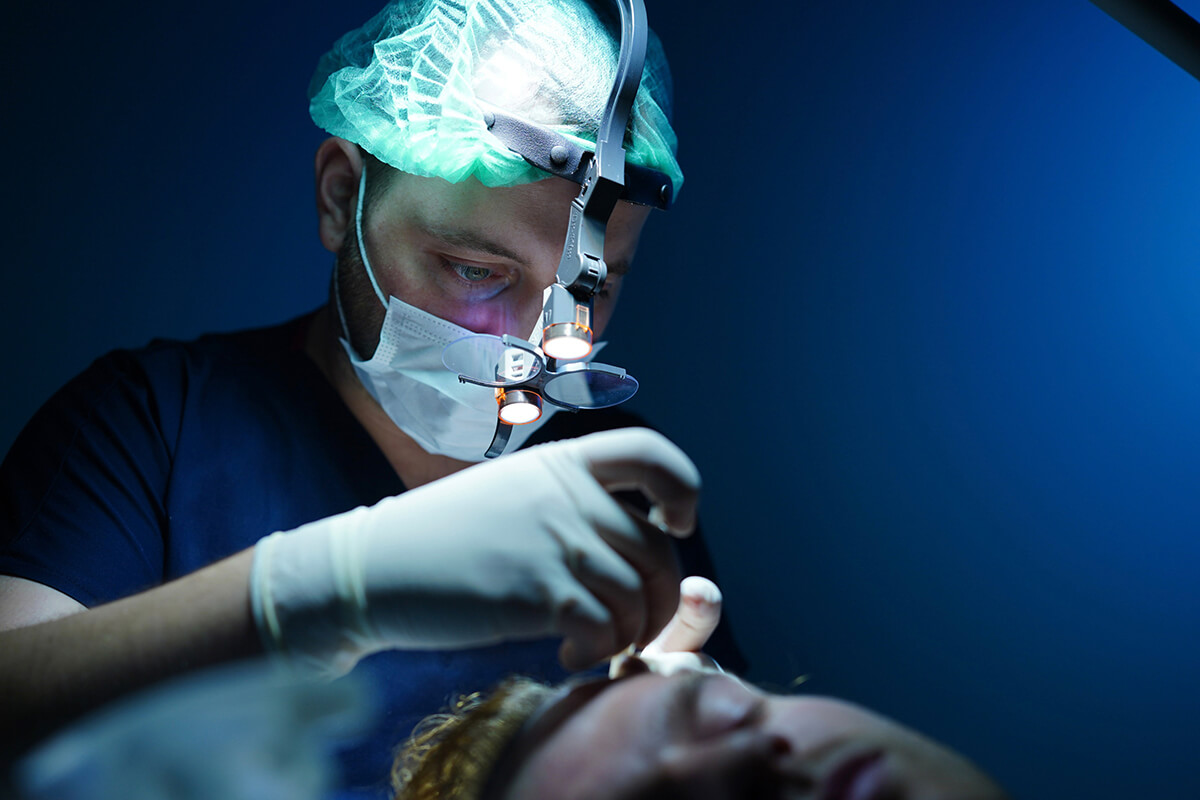
Studies published on PubMed and data from the International Society of Hair Restoration Surgery (ISHRS) show that the DHI technique can reach graft survival rates of up to 95 percent when performed by trained professionals.
Dr. Ahmet Murat – Hermest Hair Transplant Clinic:
“DHI allows us to focus on design. Each graft becomes part of the face’s frame, not just a patch of new hair.”
DHI vs FUE: Which suits you better?
Many people think DHI has replaced FUE, but that’s not true. FUE still works better for patients with extensive baldness because it covers larger areas faster. DHI, however, shines in hairline refinement, temple correction, and density restoration, where accuracy matters more than speed.
Dr. Güncel Öztürk – HairNeva Clinic:
“FUE is like painting with a wide brush, while DHI is using a fine pen. Both create beauty when used for the right purpose.”
The European Hair Restoration Society (EHRS) notes that both methods yield permanent results when performed under proper medical protocols. However, DHI tends to cause less bleeding, less crusting, and offers a faster recovery, which is why it has become one of Turkey’s most sought-after options among medical tourists.
Average Cost of DHI Hair Transplant in Turkey (2025)
If you’re searching for “DHI hair transplant in Turkey cost”, you might expect a single number. But the truth is more layered, and that’s okay.
Let’s look at what you’re really paying for, what most clinics charge, and why there’s variation. Yes, it’s a little messy but understanding the detail saves stress later.
What do quoted prices really mean?
The typical DHI hair transplant Turkey package in 2025 ranges between $2,500 and $6,000 USD, depending on graft count, technique, surgeon experience, and inclusions.
For example:
- Entry-level (small hairline area, fewer grafts): around $2,500–$3,500
- Mid-level (frontal plus temples, 3,000-4,000 grafts): around $3,000–$4,500
- Premium (dense packing, hybrid techniques, 4,000+ grafts, luxury package): $5,000–$6,000+
I’ve reviewed dozens of price lists and worked with travel-medical clients who landed quotes from three different Istanbul clinics, same hair loss pattern, same donor capacity, but saw a range of $3,200 to $5,800 for the same 3,200 graft scenario.
The difference? Technique label (“DHI”), surgeon reputation, and included services (hotel nights, PRP, aftercare).
Why does DHI cost more than standard FUE?
Because DHI uses the specialized CHOI pen plus higher surgical precision. Clinics say the tools alone can add $500-$1,000 to cost lists.
Also the time per graft is higher, and the surgeon involvement tends to be deeper. So the DHI hair transplant Turkey average cost is higher than standard FUE, which may run from $1,500 to $4,000.
Here’s a simple breakdown:
| Technique | Avg Price Turkey | What Affects Price |
|---|---|---|
| DHI | $2,500 – $6,000 | Grafts, surgeon, hotel, transfers, extras |
| FUE | $1,500 – $4,000 | Similar factors, less precision tool cost |
Real-life example: 3,000 grafts, DHI technique, Istanbul clinic
One visitor we spoke with (anonymous, but shared consent) had 3,000 grafts via DHI in Istanbul at Hermest, in early 2025. His all-inclusive package (hotel, VIP transfer, translation, medications) cost $3,900 USD.
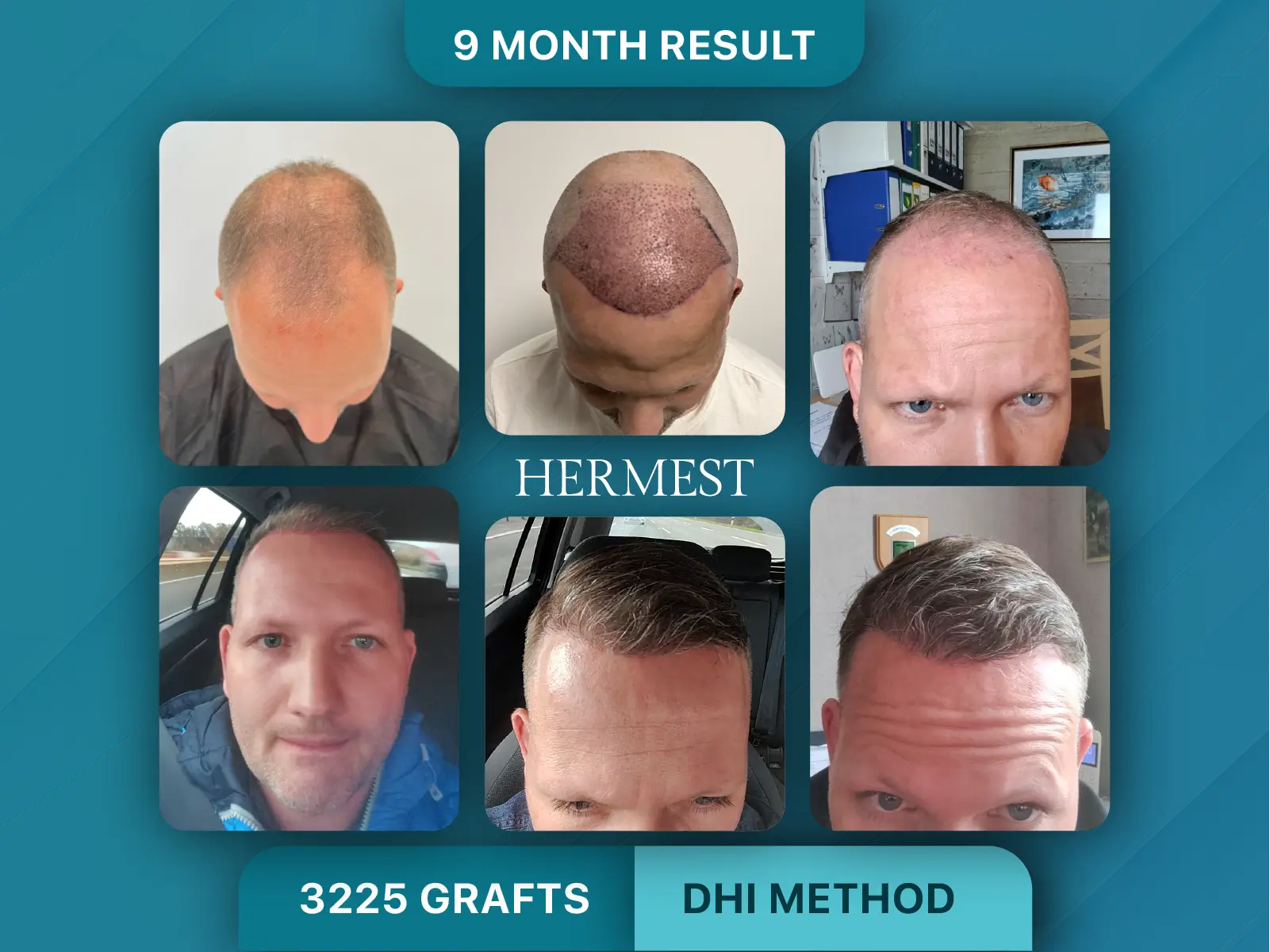
He flew from the UK. Recovery took five days before flying home. He confirmed coverage of up to 3,000 grafts only; extras cost extra.
The result? By month nine, he reported ~90% graft survival and a hairline he described as “natural, no tell-tale signs.” He said elsewhere his UK quote had been £8,500 and didn’t include hotel stay. The cost gap became obvious.
What you can ask to make sense of any quote
- How many grafts are included in the quoted price?
- Is the surgery surgeon-led (or largely technician-executed)?
- What’s included: hotel nights, transfers, medications, follow-ups?
- Is it a DHI technique with CHOI pen, or standard FUE relabelled?
- What’s the warranty or revision offer if survival is below expectation?
Istanbeautiful team insight:
“A quote under $2,000 for DHI usually means fewer grafts, heavy technician involvement, or an overseas partner handling parts. You might save money, but you’ll give up clarity, control, or post-care.”
All-Inclusive DHI Packages in Turkey
When clinics in Istanbul advertise an “all-inclusive DHI hair transplant Turkey package”, it sounds like everything is covered. But what “everything” means can vary a lot. Some packages are generous and transparent, others hide small extras that show up after arrival.
Here’s what’s usually included, what’s not, and how to tell a real deal from marketing fluff.
What’s included in a typical DHI package
Most DHI hair transplant Turkey packages in 2025 include:
- Operation with the DHI technique (CHOI pen or hybrid method)
- Surgeon consultation and detailed hairline design
- 2–3 nights hotel accommodation in a 4- or 5-star hotel
- VIP airport transfers (airport-hotel-clinic)
- Local anesthesia and medications for post-op comfort
- PRP therapy (platelet-rich plasma) to enhance healing
- Aftercare kit with shampoo, lotion, and instruction sheets
- Interpreter support for English, German, or Arabic speakers
Some clinics even include next-day check-ups, digital before-after photography, and lifetime growth warranty cards (a newer trend).
Dr. Ahmet Murat – Hermest Hair Transplant Clinic:
“Patients should look for transparent packages. A real DHI deal means the surgeon performs the implantation personally, not just supervises it. That’s what defines quality in DHI.”
What might cost extra
A few items are not always part of standard packages:
- Extra grafts beyond the stated range (often charged per 100 grafts)
- Additional PRP sessions or exosome therapy
- Post-operative laser therapy for healing boost
- Extended hotel stays if you prefer to rest longer
- Special anesthesia types (like needle-free systems)
- Travel costs to and from Turkey (flights are separate)
USHAŞ (International Health Services Inc.) reports that most international patients spend around $4,000–$4,500 total, including airfare and hotel nights, when choosing trusted JCI-accredited clinics.
Dr. Gökhan Bilgin – Smile Hair Clinic:
“Our DHI patients often combine their surgery with short Istanbul breaks. A central hotel makes a big difference. You recover better when you can actually walk outside, grab a Turkish coffee, and breathe a little.”
How to spot a trustworthy DHI package
- Ask for a written treatment plan before flying
- Check if the surgeon’s name appears on your operation schedule
- Confirm that aftercare and PRP are included in writing
- Verify the clinic’s Ministry of Health license number (Sağlık Bakanlığı)
- Avoid clinics that quote unrealistically low prices or can’t specify graft limits
According to the Turkish Health Tourism Association (THTC), around 70 percent of patient complaints come from miscommunication about what was actually included in “all-inclusive” offers. Transparency is the difference between a comfortable experience and a stressful one.
Istanbeautiful team tip:
“The best DHI packages feel like well-planned trips, not sales traps. If a clinic sends you a day-by-day schedule before you even buy the ticket, that’s usually a good sign.”
Best DHI Hair Transplant Clinics in Turkey
We visited the best hair transplant clinics in Istanbul Turkey, to gain firsthand insights into their facilities, techniques, and patient care standards. For a detailed breakdown of each clinic, please visit our full guide: 10 Best Hair Transplant Clinics in Istanbul Turkey: Our Review
Hermest Hair Transplant Clinic (Dr. Ahmet Murat)
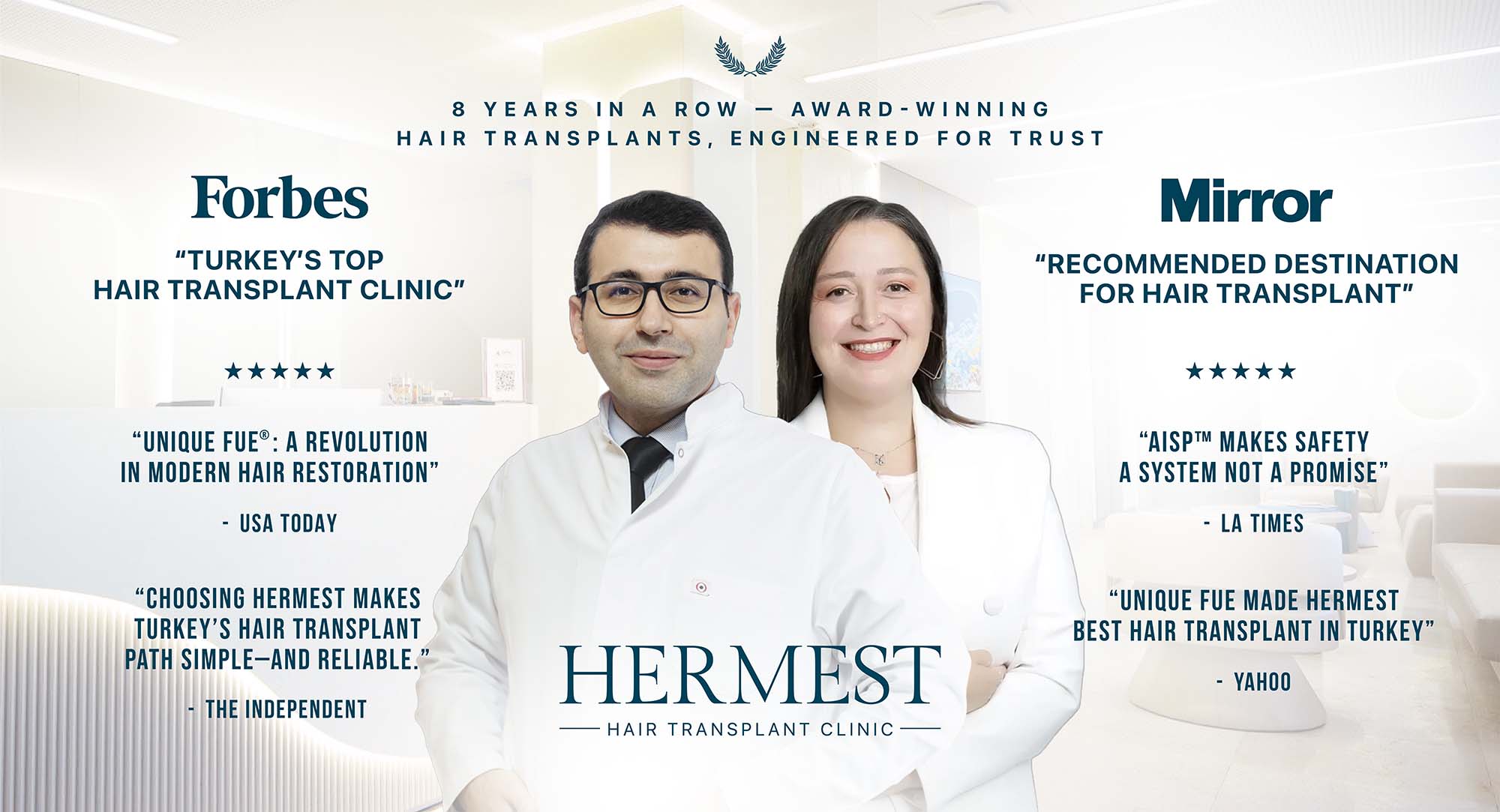
- Website: hermestclinic.com
- Techniques Offered: UNIQUE FUE®, Sapphire FUE, DHI
- Accreditations: ISHRS, Ministry of Health, THTC-compliant
- Experience: Over 10 years, 12,000+ transplants
- Rating: 4.9 based on 950+ Google reviews
- Price Range: $2,500–$4,000
In Kadıköy, you’ll find one of Istanbul’s most quietly respected clinics, Hermest Hair Clinic. Founded by Dr. Ahmet Murat, Hermest built its reputation on results that speak louder than marketing. Patients often mention one thing: the doctor’s hands-on involvement from start to finish.
Dr. Murat developed the UNIQUE FUE® method, a refined version of FUE that focuses on higher graft survival and natural density. It’s paired with the AIS Protocol, designed to create a soft, natural-looking hairline that matches your facial features. Every surgery happens inside an A+ hospital setting with full medical supervision.
Istanbeautiful Team Insight:
“We spent a day inside Hermest. The energy was calm, focused, and quietly confident. Dr. Murat personally reviewed graft plans between cases, you don’t see that level of care every day.”
Note: Please fill out the form at the bottom of the page to reach Hermest Clinic to get a quote and consultation, plus special discount.

Smile Hair Clinic (Dr. Mehmet Erdoğan & Dr. Gökay Bilgin)
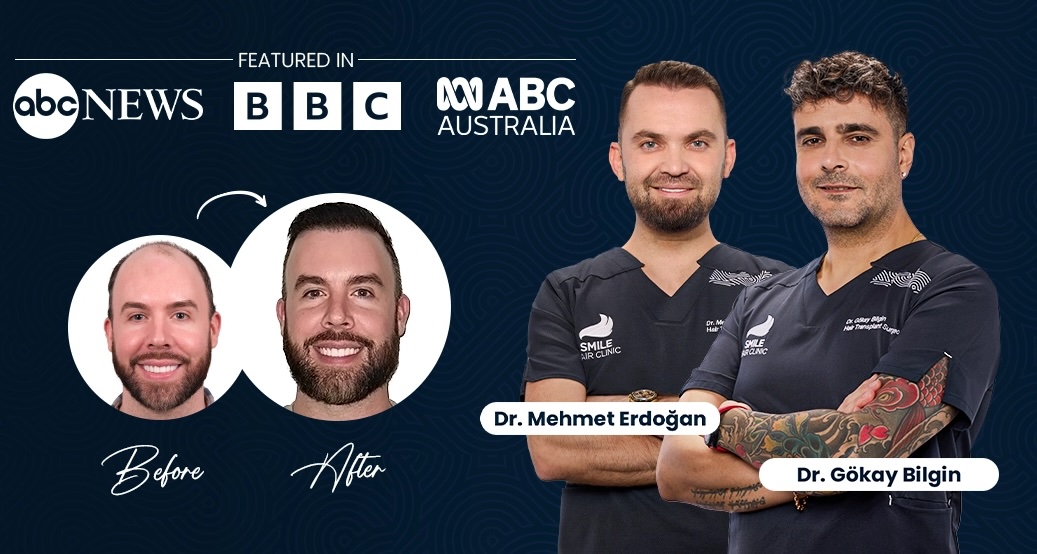
- Website: smilehairclinic.com
- Techniques Offered: FUE, DHI, Sapphire FUE
- Accreditations: ISHRS, EHRS, Ministry of Health (License)
- Experience: Over 10 years, 10,000+ transplants
- Rating: 4.9 based on 2000+ Google reviews
- Price Range: $3,500–$4,200
Smile Hair Clinic has become a familiar name in Istanbul’s medical community, led by Dr. Mehmet Erdoğan and Dr. Gökay Bilgin. Their signature True™ Philosophy puts the patient’s journey at the center of everything from the first consultation to the 12th-month checkup.
The clinic combines advanced Sapphire FUE and DHI techniques with a simple idea: restoration should feel human. Every detail, from hairline design to aftercare support, is doctor-led and transparent. The space itself feels less like a hospital, more like a calm retreat built for trust.
Istanbeautiful Team Insight:
“Smile isn’t just a name, it’s how most patients actually leave. Both doctors take time to explain, to listen, to make sure no step feels rushed. That’s rare.”
Note: Please fill out the form at the bottom of the page to reach Smile Clinic to get a quote and consultation, plus special discount.

HairNeva Hair Transplant Clinic (Dr. Güncel Öztürk)
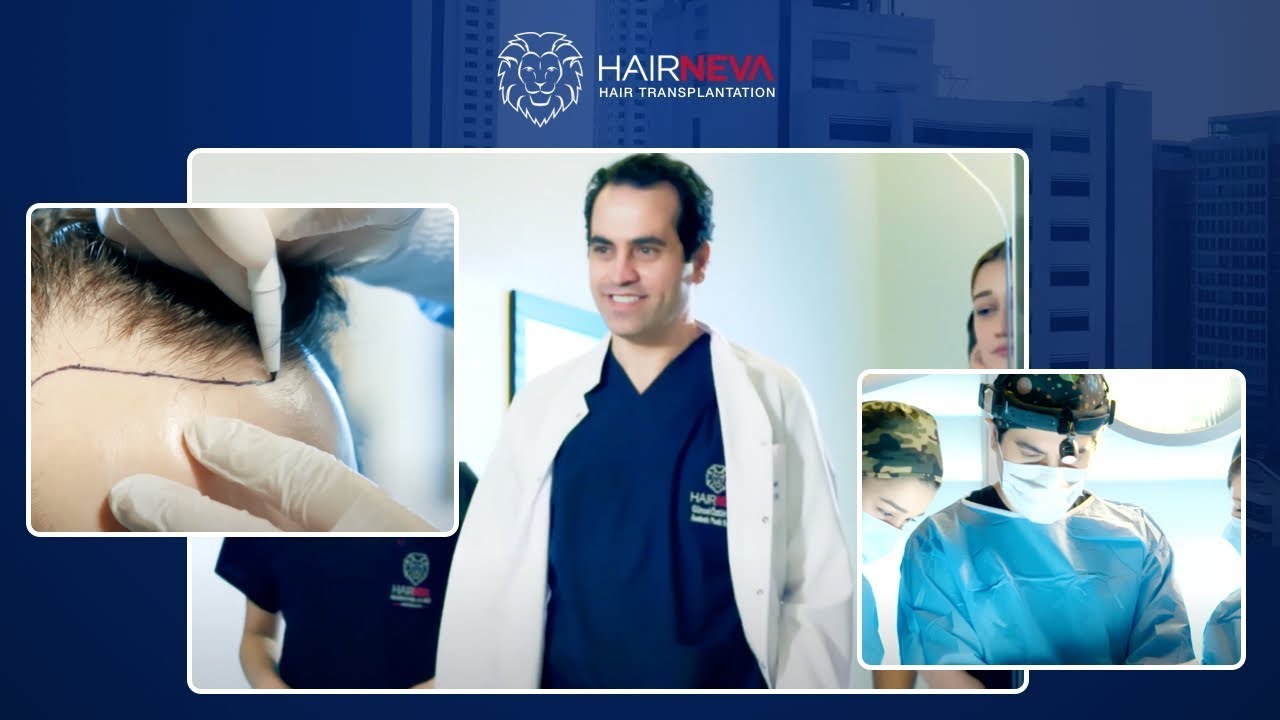
- Website: hairneva.com
- Techniques Offered: Sapphire FUE, DHI, PRP-assisted transplants
- Accreditations: Ministry of Health, EHRS
- Experience: Over 12,000 successful procedures
- Rating: 4.9 based on 750+ Google reviews
- Price Range: $3,250–$4,300
HairNeva, led by Assoc. Prof. Dr. Güncel Öztürk, is where surgical science meets artistic precision. A certified EBOPRAS plastic surgeon, Dr. Öztürk performs every operation inside Acıbadem Fulya Hospital, combining clinical safety with a personal artistic touch.
Each procedure is tailored with no templates, no shortcuts. HairNeva’s philosophy is rooted in ethics, aesthetics, and empathy. Patients often say they felt more like collaborators in their transformation than clients in a queue.
Istanbeautiful Team Insight:
“Watching Dr. Öztürk plan a patient’s hairline felt like seeing an artist sketch before sculpting. Every movement had intent. It’s subtle, but you can feel the difference in his results.”
Note: Please fill out the form at the bottom of the page to reach HairNeva to get a quote and consultation, plus special discount.

Sapphire Hair Clinic (Spec. Dr. Dilek Çay)

- Website: sapphirehairclinic.com
- Techniques Offered: Sapphire FUE, DHI
- Accreditations: Ministry of Health
- Experience: Over 10 years
- Price Range: $2,000–$3,500
At Sapphire Hair Clinic in Şişli, medical care meets hospitality in a way that feels effortless. The clinic offers FUE, DHI, and Sapphire FUE hair transplants under the supervision of Spec. Dr. Dilek Çay, a respected anesthesiology and resuscitation specialist who oversees each patient’s comfort and safety.
Everything here runs smoothly with clear communication, gentle care, and a patient-first rhythm that never feels rushed. The clinic even arranges luxury hotel stays and personal coordinators for international visitors. You leave not only with new hair but also with the sense that someone truly looked after you.
Istanbeautiful Team Insight:
“We noticed how calm everything felt at Sapphire. Dr. Çay personally checked in before anesthesia, just a few minutes of genuine reassurance that instantly changed the room’s energy.”
Note: Please fill out the form at the bottom of the page to reach Sapphire Clinic to get a quote and consultation, plus special discount.

Dr. Terziler Exclusive Clinic (Dr. Servet Terziler)
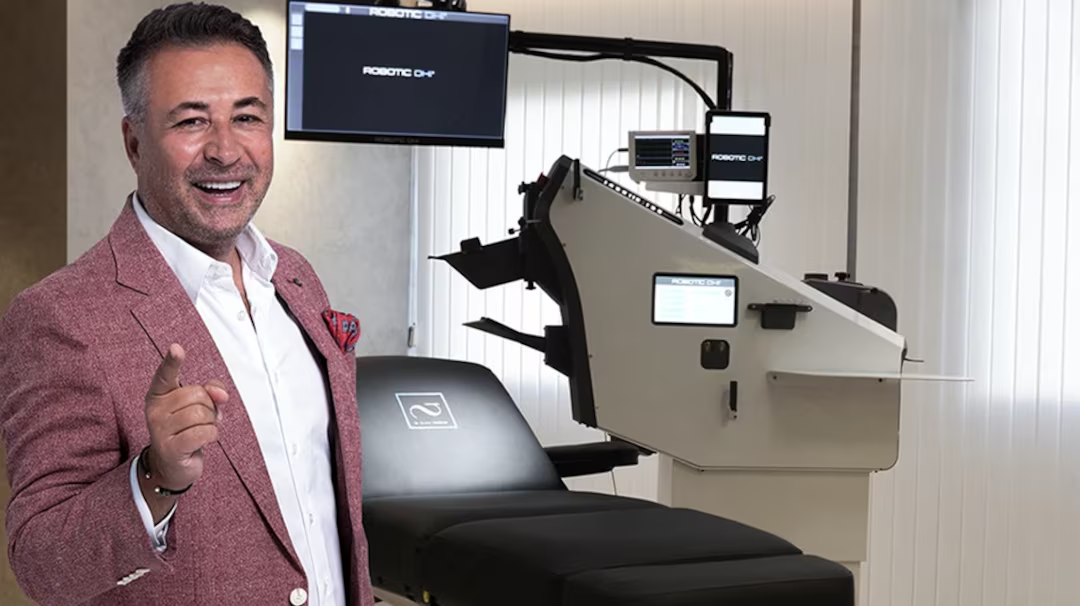
- Website: drterziler.com
- Techniques Offered: Picasso Robotic DHI, Robotic DHI, and Sapphire FUE
- Accreditations: Ministry of Health
- Experience: Over 30 years
- Price Range: $3,000–$4,500
Few names carry as much weight in Turkish aesthetics as Dr. Servet Terziler. With over 35 years of experience, his clinic in Etiler blends surgical innovation with the precision of fine art. Known as the “Picasso of Hair,” Dr. Terziler introduced Robotic DHI technology to Turkey, and continues to refine the craft with Sapphire and regenerative treatments.
Patients describe the clinic as “five-star calm”: suites instead of rooms, art on the walls, and a doctor whose presence commands both confidence and warmth.
Istanbeautiful Team Insight:
“What struck us wasn’t the luxury, it was the discipline. Every move at Terziler Clinic feels intentional, like a perfectly rehearsed performance. You can tell you’re in practiced hands.”
Note: Please fill out the form at the bottom of the page to reach Dr Terziler Clinic to get a quote and consultation, plus special discount.

MedArt Hair (Dr. Ömer Aykut Sumer)
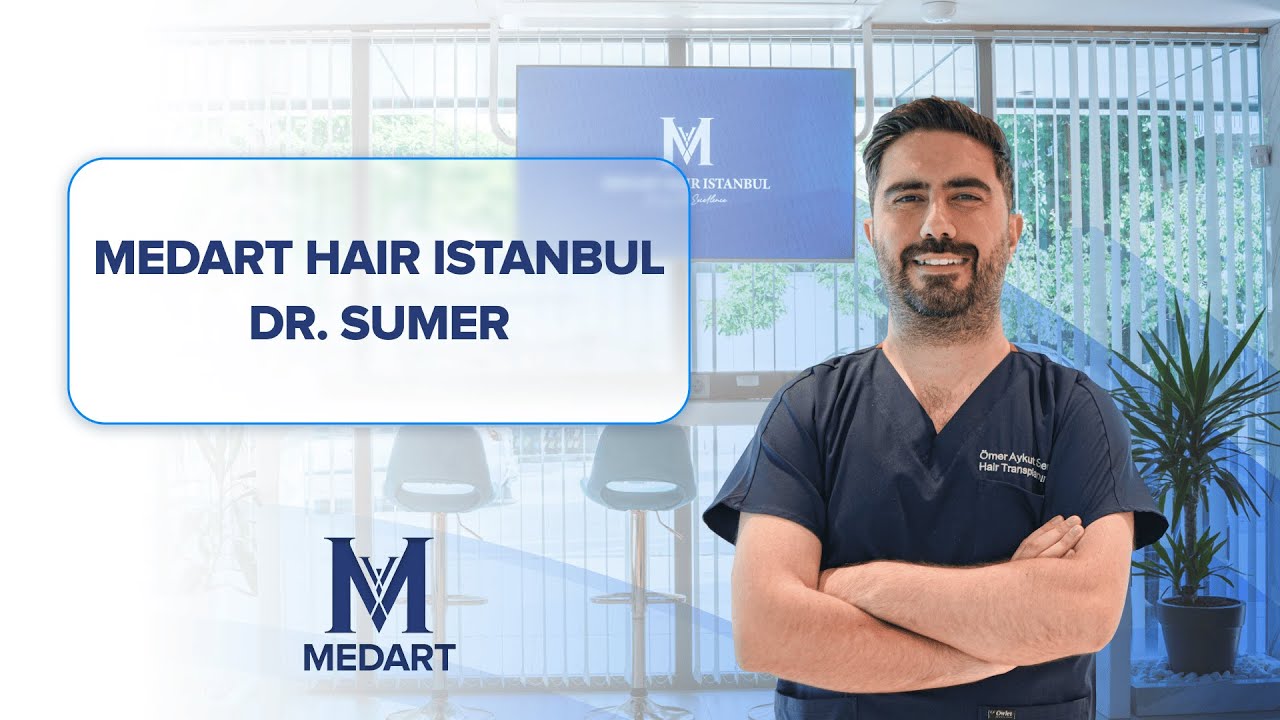
- Website: medartinternational.com
- Techniques Offered: DHI, FUE and Sapphire FUE
- Accreditations: Ministry of Health
- Experience: Over 10 years
- Rating: 5.0 based on 300+ Google reviews
- Price Range: $3,000–$4,000
MedArt Hair stands out for its boutique approach, small volume, high attention, and a true focus on the individual. Founded by Dr. Ömer Aykut Sümer, a GMC-registered surgeon with experience in both Turkey and the UK, the clinic blends FUE, DHI, and Stem Cell Hair Transplants within a luxury yet approachable framework.
What makes MedArt different is pace. They don’t rush to fit more patients, they slow down to get it right. That’s why international clients, especially from the UK, call it “the Harley Street of Istanbul.”
Istanbeautiful Team Insight:
“Dr. Sümer talks less like a salesman and more like a craftsman. You can sense that he takes your trust seriously, and that changes the whole experience.”
Note: Please fill out the form at the bottom of the page to reach MedArt Hair Clinic to get a quote and consultation, plus special discount.

Aslı Tarcan Clinic
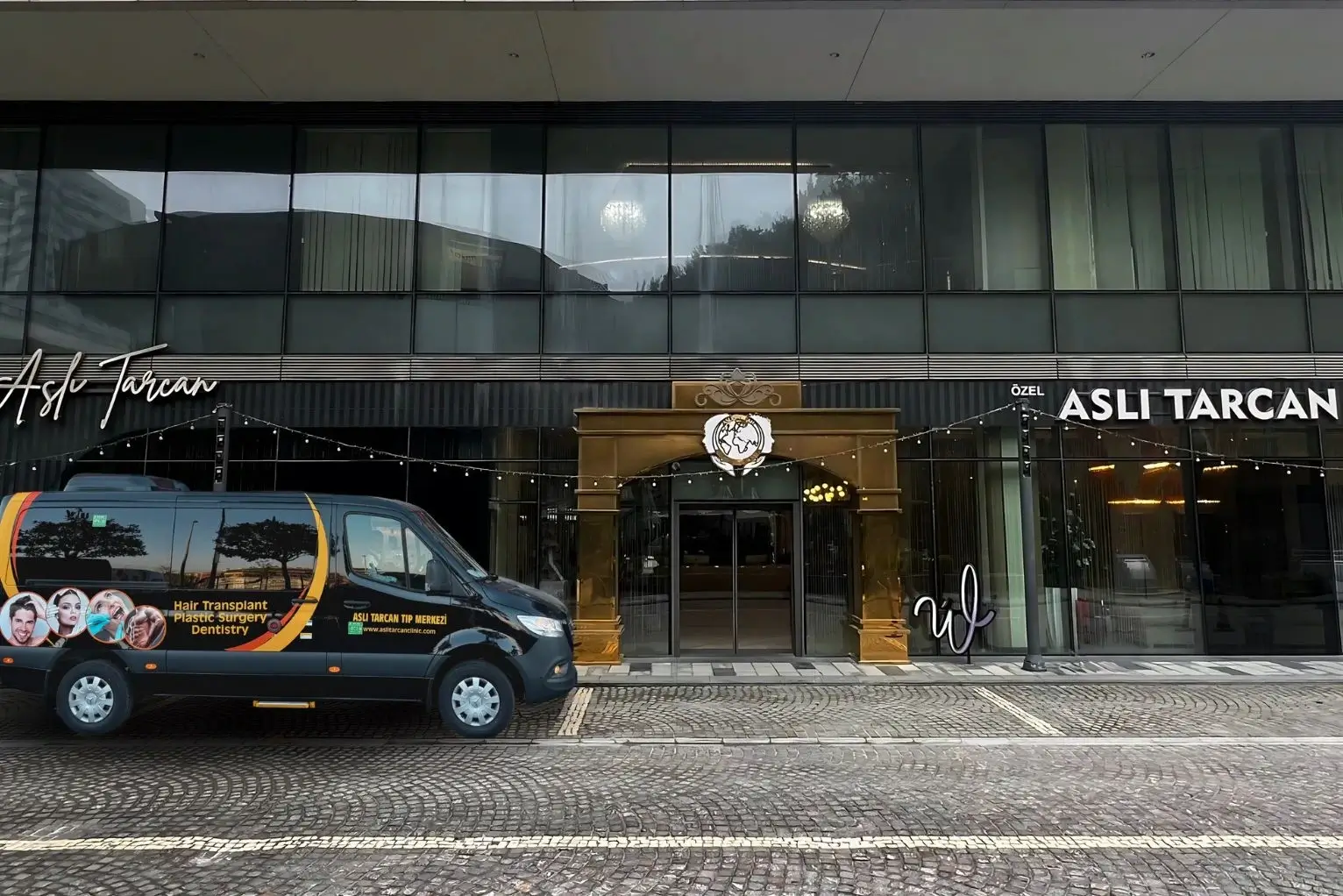
- Website: aslitarcanglobal.com
- Techniques Offered: DHI, FUE and Sapphire FUE
- Accreditations: Ministry of Health (License)
- Experience: Over 20 years
- Rating: 4.8 based on 2300+ Google reviews
- Price Range: $2,500–$3,500
Located in Zeytinburnu, Aslı Tarcan Clinic is one of Istanbul’s most recognized names in FUE, DHI, and Robotic DHI hair transplants. Led by Aslı Tarcan, who has spent over 20 years in medical aesthetics, the clinic stands out for its clarity and care.
The team’s strength lies in communication, every patient knows what’s happening and why. They also specialize in Afro-textured hair and female hair restoration, areas where precision and patience are key. The environment feels open, professional, and calm, a space where questions are encouraged and answers are clear.
Istanbeautiful Team Insight:
“It felt like everyone spoke the same language, not Turkish or English, but clarity. They didn’t oversell or overpromise. Just honest, grounded care.”
Note: Please fill out the form at the bottom of the page to reach Aslı Tarcan Clinic to get a quote and consultation, plus special discount.

HEVA Clinic

- Website: dentalhairclinicturkey.com
- Techniques Offered: FUE, Sapphire FUE, DHI, Afro Hair Transplant
- Accreditations: ISHRS, JCI Hospital, Ministry of Health (License)
- Experience: Over a decade of medical excellence
- Rating: 4.9 based on 1750+ Google reviews
- Price Range: $2,600–$4,500
Heva Clinic is one of Istanbul’s modern success stories, a seven-floor medical center where hair and dental restoration meet comfort and trust. The clinic is led by an ISHRS-affiliated medical director, supported by surgeons who specialize in Afro-textured, Asian, and European hair types.
Every detail feels intentional from private operating rooms to their aftercare mobile app, which lets patients track recovery and message the team directly. It’s a mix of precision and hospitality that’s earned Heva a loyal international following.
Istanbeautiful Team Insight:
“Heva runs like a well-tuned orchestra, quiet efficiency, no chaos, no rush. Their aftercare follow-up system impressed us the most. It’s rare to feel that supported even after flying home.”
Note: Please fill out the form at the bottom of the page to reach HEVA Clinic to get a quote and consultation, plus special discount.

Yaman Surgery Center (Dr. Resul Yaman)
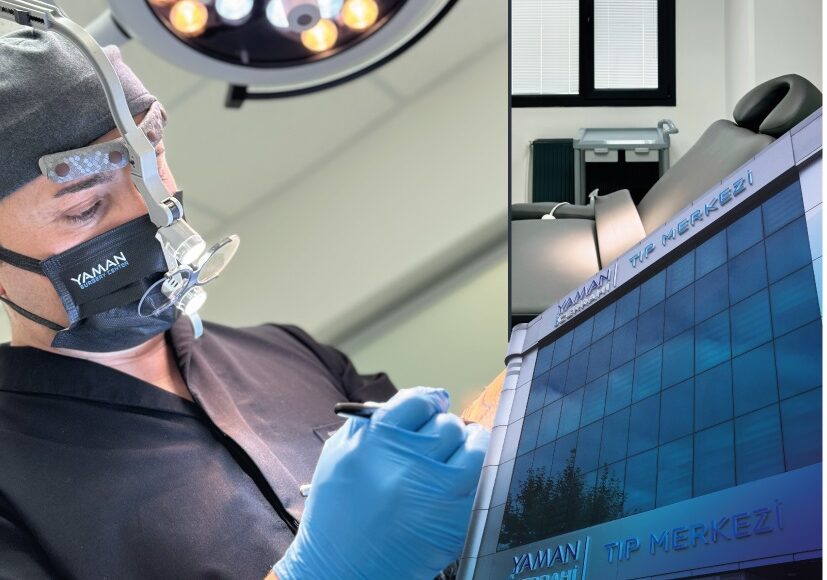
- Website: resulyaman.com
- Techniques Offered: FUE, Sapphire FUE, DHI
- Accreditations: Ministry of Health
- Experience: Over 20 years
- Rating: 4.6 based on 50+ Google reviews
- Price Range: $3,750–$6,000
At Yaman Surgery Center, Dr. Resul Yaman has built a following by doing what many clinics stopped doing, being fully hands-on. With over 15 years of experience, he personally performs the incision phase of every transplant and closely monitors each case from consultation to recovery.
Patients describe him as calm, direct, and deeply focused on surgical detail. The clinic’s use of single-use tools, sterile conditions, and a one-patient-per-day model shows that quality still comes before quantity.
Istanbeautiful Team Insight:
“There’s a quiet confidence in Dr. Yaman’s approach. He doesn’t delegate the critical parts, and that decision shows in every natural result we saw.”
Note: Please fill out the form at the bottom of the page to reach Dr. Yaman Clinic to get a quote and consultation, plus special discount.

Soraca Med

- Location: Antalya and Istanbul, Turkey
- Rating: 5 based on 55+ Google reviews
- Price Range: $2,350–$4,000
Though newer than others on this list, Soraca Med stands out for its hospitality and personalized approach. The team runs medical tourism with warmth and efficiency, providing full packages that include transfers, accommodation, and dedicated aftercare.
Istanbeautiful Insight: “They remind you what healthcare should feel like — calm, clear, and human.”
Note: Please fill out the form at the bottom of the page to reach Soraca Med to get a quote and consultation, plus special discount.

Unshaven DHI Hair Transplant in Turkey
One of the most common questions we get from travelers is, “Can I get a DHI hair transplant without shaving my head?” The answer is yes, and it’s one of the reasons unshaven DHI has become so popular in Istanbul.
What makes unshaven DHI different?
The technique itself is identical to standard DHI hair transplant in Turkey, but only a small donor area at the back of the head is trimmed. The rest of your hair stays untouched, so the surgery remains discreet.
Doctors use fine-tipped CHOI pens to implant grafts between existing hairs without damaging them, maintaining natural spacing and direction. It takes more time and focus, but for professionals, models, or anyone who wants privacy, it’s worth it.
Dr. Gökhan Bilgin – Smile Hair Clinic:
“Unshaven DHI demands patience and precision. We often say it’s a surgery for artists — each graft must be placed with awareness of the surrounding hair.”
Who it’s ideal for
- Patients with early or moderate hair loss (2,000–2,800 grafts)
- People who can’t or don’t want to shave their scalp for personal or work reasons
- Women seeking hairline or crown correction
- Men with long hairstyles who prefer subtle changes
According to Zito & Raggio, StatPearls (2024), unshaven methods are particularly suitable for partial transplants, where precision outweighs graft count.
How long does it take?
Because visibility is limited, unshaven DHI usually takes 1–2 hours longer than standard DHI. Most procedures range between 6 and 8 hours, depending on graft numbers. The cost is slightly higher too — typically 10–20% more than regular DHI packages — because of the slower pace and higher surgeon involvement.
Healthline notes that the unshaven approach helps patients maintain confidence immediately after surgery, as the donor area remains easily concealed within longer hair.
Istanbeautiful team note:
“If you value a low-profile recovery, unshaven DHI is your best match. Just make sure your surgeon confirms graft limits in advance — precision, not volume, is the secret to great results.”
Travel, Logistics & True Trip Cost for DHI Visitors
So you’ve found a clinic, checked reviews, and booked a package. The next big question is: how much will your DHI hair transplant trip to Turkey really cost once you include everything — flights, hotels, meals, and recovery time? Let’s unpack it like travelers, not just patients.
Flights to Istanbul: what to expect
Turkey’s advantage starts before you even land. Istanbul has direct flights from over 100 countries, and tickets are usually cheaper than you think.
Here’s an average round-trip fare snapshot for 2025 (based on data from Turkish Airlines and Skyscanner):
| Departure City | Avg. Flight Cost (USD) | Duration |
|---|---|---|
| New York (JFK) | $700 – $950 | 9.5 hrs |
| London (LHR) | $180 – $300 | 4 hrs |
| Berlin (BER) | $150 – $250 | 3 hrs |
| Dubai (DXB) | $250 – $400 | 4.5 hrs |
| Toronto (YYZ) | $850 – $1,100 | 10 hrs |
Flights are usually handled separately, though some DHI hair transplant Turkey packages help arrange discounted fares through medical tourism agencies. If you’re flying from the U.S. or Canada, expect a total travel time of about 12–14 hours including layovers.
Hotels and stay duration
Most DHI patients stay in Istanbul 4 to 5 days. That covers:
- Arrival and consultation day
- Surgery day
- Post-op check or PRP session
- Short recovery and sightseeing
All-inclusive packages include 2–3 hotel nights, usually in 4-star hotels near the clinic (Kadıköy, Şişli, Taksim, or Beşiktaş). Extra nights cost about $80–$120 per night if you extend your stay. For those traveling with companions, hotels can upgrade to twin rooms or small suites.
Dr. Güncel Öztürk – HairNeva Clinic:
“The best recovery doesn’t happen in the clinic, it happens in comfort. We encourage our international guests to stay at least one extra night after the first wash — they feel more confident flying home.”
Daily expenses and aftercare
Even if your package is inclusive, plan for small extras:
- Meals: $20–$40 per day (unless hotel includes breakfast)
- Transportation: public transport or taxis ($10–$15 daily average)
- Aftercare products: sometimes you’ll want extra shampoo or spray ($30–$50)
- Leisure: Bosphorus dinner cruise or light sightseeing (~$60–$120)
According to USHAŞ (International Health Services Inc.), the true cost of a full DHI trip to Turkey averages $4,000–$4,800, depending on where you fly from and how long you stay.
Istanbeautiful team note:
“We’ve followed dozens of patients who turn their DHI trip into a short city break. Istanbul makes it easy — one morning you’re in a clinic, and the next evening you’re sipping tea along the Bosphorus watching ferries cross continents.”
Why Istanbul is built for medical travelers
The Republic of Türkiye Ministry of Health actively licenses and monitors medical tourism clinics, ensuring hygiene and safety compliance. Istanbul’s infrastructure is built around it — from multilingual airport staff to hotel drivers trained for post-op patients.
Most patients describe the process as “unexpectedly smooth”. And it is. You fly in, get greeted by your driver, check in, and the next morning your medical coordinator walks you through every step. By the time you leave, Istanbul feels less like a foreign city and more like a place that understands your journey.
How Many Grafts Does a DHI Transplant Cover? Expectations & Results
When people ask, “How many grafts do I need for a DHI hair transplant in Turkey?” they usually mean, “How much coverage can I realistically expect?” And that’s the right question.
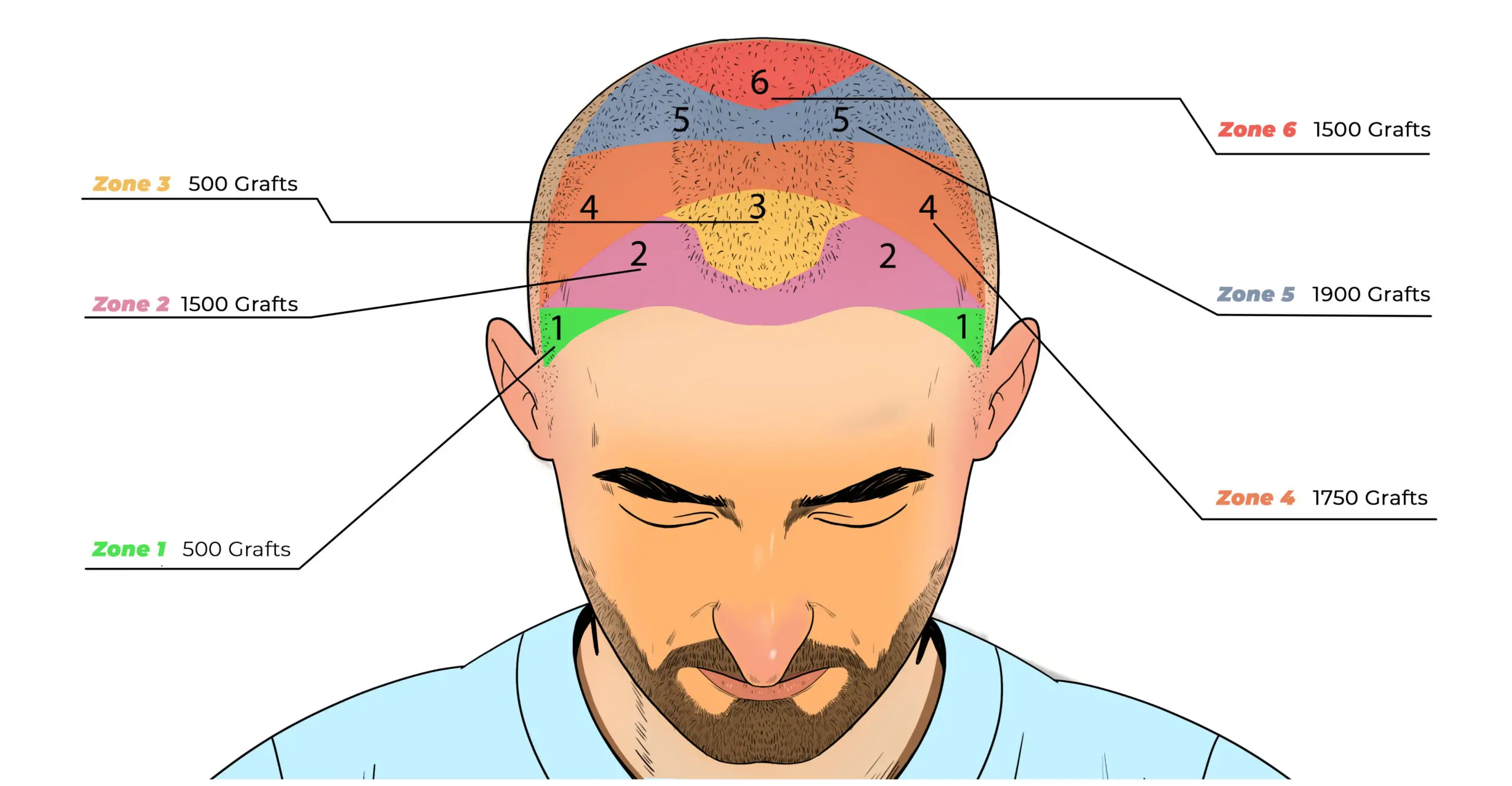
Graft numbers are not just math, they define how natural your result will look, how dense it’ll feel under your fingers, and how long your new hairline will last.
Typical graft ranges for DHI
Most DHI hair transplants in Turkey use between 2,000 and 4,000 grafts. Because DHI takes more surgical precision per follicle, it’s not meant for very large areas in one session like traditional FUE.
Here’s a general idea:
| Baldness Level | Typical Grafts (DHI) | Coverage Goal |
|---|---|---|
| Hairline / Temples | 1,500–2,500 | Define front and shape |
| Frontal & Mid-Scalp | 2,500–3,500 | Restore density |
| Crown (Vertex) | 1,000–2,000 | Fill thinning zone |
| Full Restoration | 4,000+ | Multiple sessions required |
Each graft contains 1–4 hairs, so 3,000 grafts usually mean 6,000–9,000 hairs. Clinics like Smile Hair and Hermest often use digital tools during the consultation to estimate this. Patients can see simulated density before surgery, which helps set expectations honestly.
Dr. Gökhan Bilgin – Smile Hair Clinic:
“The mistake many people make is chasing graft numbers instead of quality. DHI is about control. 2,800 precise grafts placed correctly can look fuller than 4,000 placed poorly.”
DHI’s density advantage
DHI doesn’t require channel opening beforehand, which allows doctors to implant grafts closer together, typically around 40–60 grafts per cm². That’s why the final result often looks denser, even with fewer total grafts.
A StatPearls (2024) overview explains that DHI provides better direction and angle precision, leading to improved hairline realism, especially in areas of fine detail like temples or sideburns.
Recovery timeline and visible growth
After a DHI hair transplant Turkey, scabbing usually resolves within 7–10 days. Shedding happens in weeks 3–6, followed by visible regrowth around month 3. By month 6, 60–70% of grafts start to show. Full density appears by month 12–14.
Healthline notes that DHI recovery tends to be slightly faster than standard FUE because of smaller incisions and less bleeding.
What affects the final result
- Surgeon experience and CHOI pen handling
- Donor area quality and extraction pattern
- Graft hydration and out-of-body time
- Post-care routine (washing, sleeping, PRP support)
- Nutrition and stress levels after the operation
According to ISHRS 2024 Census Data, Turkey ranks among the top three countries globally for hair transplant success rates, with an average graft survival rate above 90 percent when performed in certified facilities.
Istanbeautiful team note:
“We’ve seen DHI results up close, the subtle temple curves, the softness around the forehead. It’s artistry built on science, and that’s what makes Istanbul’s clinics stand out internationally.”
DHI Hair Transplant Recovery Timeline & Tips
One reason travelers love DHI hair transplant in Turkey is how quickly life goes back to normal. Because the method doesn’t involve traditional incisions or wide channel openings, the recovery feels lighter, with less swelling, fewer scabs, and barely any downtime. Most people are surprised by how quietly their healing unfolds.
Your DHI recovery, week by week
Day 1–3: A little swelling on the forehead, a touch of redness around the implanted area. No bandages needed. You’ll feel more like you’ve had a facial than surgery.
Day 4–7: Tiny scabs begin forming. This stage matters most — your washing technique makes all the difference. Clinics like Smile Hair and Hermest provide special foam cleansers and gentle massage guides.
Day 7–10: Most scabs fall off naturally. Redness fades, and the donor area starts looking normal again. You can usually return to desk work by now.
Weeks 2–3: The “shock shedding” phase. Don’t panic when transplanted hairs fall out. The follicles stay rooted under the skin — they’re just resetting their growth cycle.
Months 1–3: Not much to see yet, but work is happening underneath. New roots are forming blood supply connections.
Months 4–6: Tiny hairs begin to break through. This is the first visible sign that your DHI procedure worked.
Months 6–12: Density starts building steadily. Most patients notice major improvement around month 9.
Months 12–15: The final shape appears. You can style your new hair freely — wash, cut, even color it if your doctor agrees.
Practical tips for healing
- Follow your clinic’s washing routine exactly as shown.
- Avoid direct sunlight for the first two weeks.
- Skip tight hats or helmets during the first 10 days.
- Sleep slightly upright for 3–4 nights to reduce swelling.
- Stay away from smoking and alcohol for at least 10 days.
- Use saline spray if prescribed to keep grafts hydrated.
- Postpone gym, swimming, or heavy lifting for two weeks.
Istanbeautiful Team Advice:
“Most of our readers said they were back to remote work within three days after DHI. But gym routines, long flights, or outdoor trips should wait at least 10–14 days. Let your scalp rest, it’s quietly building your new hairline.”
Aftercare Essentials Checklist (DHI in Turkey)
Here’s what top Istanbul doctors recommend to protect your new grafts and keep recovery on track. Think of it as your pocket guide after surgery.
Washing Routine
- Use only the clinic’s shampoo and foam for 10 days.
- Pat dry gently — no towels or rubbing.
- Follow the video or printed steps your clinic gives you.
Sleeping Position
- Sleep at a 45° angle for the first few nights.
- Use a neck pillow or small travel cushion to avoid friction.
Sun & Weather Protection
- Avoid direct sunlight for at least 2 weeks.
- Skip saunas, steam rooms, and very hot showers.
- If you must go out, wear a loose, soft cap after day 10.
Lifestyle & Activities
- No smoking, alcohol, or caffeine excess for 10 days.
- Skip the gym, running, or heavy lifting for 2 weeks.
- Avoid swimming pools or sea water for 1 month.
Aftercare Products
- Keep your saline spray handy and use as advised.
- Don’t apply oils or styling products before 1 month.
- Ask your doctor before starting PRP, minoxidil, or vitamins.
Follow-up & Growth Tracking
- Send your clinic photos weekly during the first month.
- Book PRP or exosome follow-ups if included in your package.
- Expect visible new growth around month 3–4.
Safety, Risk & Red Flags for DHI in Turkey
The question every smart traveler eventually asks isn’t just “how much does it cost?” but “is DHI hair transplant in Turkey safe?”
The short answer is yes — when done in a licensed clinic with an experienced surgeon. The longer answer: it depends entirely on who does the work and how they do it.
What makes DHI safe in Turkey
Turkey’s medical tourism system is highly regulated. The Republic of Türkiye Ministry of Health (Sağlık Bakanlığı) licenses every surgical center that performs hair transplants. Clinics must meet hygiene, sterilization, and staffing standards.
The International Society of Hair Restoration Surgery (ISHRS) and the European Hair Restoration Society (EHRS) also recognize several Istanbul-based surgeons as members or fellows, meaning they follow global ethics and training guidelines.
Reputable clinics handle no more than one or two operations per day per surgeon, maintain sterile environments, and use FDA-approved CHOI pens and medical devices. These are small but meaningful details that separate a clinic from a production line.
Common risks and how to minimize them
No surgery is completely risk-free. Even with DHI, patients might experience:
- Mild swelling around forehead or eyes (2–3 days)
- Scabbing or redness for up to a week
- Temporary shock loss (some native hairs fall before regrowth)
- Uneven early growth, which evens out by month 6–9
According to Kerure & Patwardhan (2018) and StatPearls (2024), most complications stem from poor technique, inadequate sterilization, or excessive graft density. The key to avoiding them is qualified medical oversight, proper hydration of grafts, and post-op care that follows the surgeon’s written instructions.
Hidden fees and fake DHI claims
Several clinics advertise DHI but actually perform FUE with angled implanters, that is a cheaper variant without CHOI pens. To verify authenticity:
- Ask to see the CHOI pens before the operation.
- Check the clinic’s official Ministry of Health registration number.
- Avoid paying full price before arrival; deposits are standard, but full prepayment isn’t.
Haider (PubMed, 2024) noted that one of the biggest concerns in Turkey’s hair transplant tourism is mislabeling of techniques. Patients often arrive expecting DHI but receive standard FUE instead. Transparency is the fix.
Dr. Güncel Öztürk – HairNeva Clinic:
“Don’t let low prices fool you. DHI costs more because it takes longer and demands focus. If it’s too cheap, it’s not real DHI.”
What to look for before saying yes
- Surgeon consultation before you book flights
- Documented pre-op blood test and health screening
- Use of sterile, single-use CHOI pens
- Clear written aftercare instructions
- Available medical contact after you return home
Forbes Health (2024) lists Turkey among the safest and most affordable countries for hair restoration, largely because of its balance between medical regulation and high surgeon volume, giving doctors more hands-on experience than most Western counterparts.
Istanbeautiful team advice:
“Think of it like choosing a pilot. You don’t ask who built the plane, you ask who’s flying it. In DHI, that’s what matters most.”
FAQs About DHI Hair Transplant in Turkey
Is DHI hair transplant in Turkey safe?
Yes, when performed by a licensed clinic and an experienced surgeon. The Turkish Ministry of Health (Sağlık Bakanlığı) regulates all certified centers. Many top doctors in Istanbul are members of ISHRS and EHRS, following international surgical standards. Risks like mild swelling or temporary shedding are normal and temporary when aftercare guidelines are followed.
What’s the difference between DHI and FUE?
The key difference is implantation. FUE involves creating channels first and placing grafts manually, while DHI uses a CHOI pen to implant follicles directly. DHI gives surgeons more control over angle, depth, and direction, ideal for hairline and density refinement. FUE covers larger areas faster, making it better for extensive baldness.
How many grafts are needed for good coverage?
Most DHI hair transplants in Turkey use between 2,000 and 4,000 grafts, depending on your hair loss pattern. For hairline design, 2,000–2,500 is typical. Full coverage might require 4,000+ grafts or multiple sessions. Each graft contains 1–4 hairs, so a 3,000-graft DHI means roughly 7,000 new hairs with natural density and direction.
Who are the best DHI hair transplant doctors in Istanbul?
Among the most recognized surgeons are Dr. Gökhan Bilgin (Smile Hair Clinic), Dr. Ahmet Murat (Hermest Hair Transplant Clinic), and Dr. Güncel Öztürk (HairNeva Clinic). All three have over 10 years of experience, use genuine CHOI pens, and oversee every stage of surgery themselves. Each is known for personalized design and international patient care.
Do DHI packages in Turkey include accommodation and transfers?
Yes. Most all-inclusive DHI hair transplant packages include 2–3 hotel nights, airport transfers, PRP therapy, anesthesia, and aftercare kits. What’s not usually included are flight tickets and extra nights. According to USHAŞ data, full trip expenses (including airfare) average $4,000–$4,800 for international patients in 2025.
How long does recovery take after DHI?
Healing after DHI hair transplant Turkey is fast compared with older techniques. Redness and scabbing usually fade in 7–10 days. Shedding occurs within a few weeks, while visible growth starts by month 3. Full density typically appears between 12 and 14 months. Following your doctor’s aftercare routine (washing, sleeping posture, PRP support) speeds recovery.
Can DHI be done without shaving the head?
Yes, unshaven or partial-shave DHI is possible, especially for women or men needing localized coverage. However, it’s more time-consuming and may slightly increase the price. Many Istanbul clinics now offer unshaven DHI options for frontal hairline or temple restoration using modified CHOI pen angles and smaller extraction zones.
Do clinics offer warranties or guarantees?
Most reputable clinics provide written warranties on graft survival or regrowth. For instance, Smile Hair and Hermest both offer a 12–18 month growth guarantee if post-op instructions are followed. Avoid clinics that make unrealistic promises like “100% lifetime growth.” A 90–95% graft survival rate is the realistic standard, supported by ISHRS 2024 Census Data.
What’s the success rate of DHI in Turkey?
According to the International Society of Hair Restoration Surgery (ISHRS) and data from PubMed studies, DHI hair transplant success rates in Turkey average 90–95% graft survival when performed by trained surgeons using certified tools. Results depend on donor area quality, surgeon skill, and aftercare compliance, not just graft count or cost.